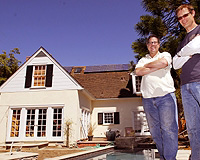 |
Upington, South Africa (AFP) Oct 28, 2010 South Africa wooed investors Thursday for what could become the world's largest solar project, built on the edge of the Kalahari Desert to provide an eighth of the country's electricity. More than 400 investors and solar industry insiders from as far away as India, South Korea, Spain and the United States descended on the tiny town of Upington in South Africa's arid Northern Cape province for a conference aimed at laying the groundwork for a 5,000-Megawatt solar park. Energy Minister Dipuo Peters said the park, whose estimated price tag is 150 billion rands (21.3 billion dollars, 15.4 billion euros), would be funded mainly by private developers that would finance and build individual projects and sell power to the national grid. She called the park a "win-win" project that would move South Africa toward a green economy and help break its long-time dependence on coal -- currently about 90 percent of the country's energy mix -- while giving investors a share in one of the world's best locations for solar power. "I know you are here to make money. We are also here to say we want you to generate power," Peters said. "But we also want to be able to create jobs for our people," she added. "We are here creating a win-win situation." The area around Upington has some of the best conditions in the world for solar power, according to a pre-feasibility study by the non-profit Clinton Climate Initiative, a clean energy programme sponsored by former US president Bill Clinton's charitable foundation. The arid Northern Cape, which sits at the edge of the Kalahari Desert, has some of the strongest sunshine in the world, relatively developed infrastructure and seemingly endless expanses of flat, empty land. "When you drive around here with a solar developer's hat on, it's magic. It's flat, there's good grid lines," said Dick Berlijn, director of project development firm Subsolar. "Both on the industrial side and also just on how it looks, it's an amazing area." Peters said the government hopes the solar park will have a capacity of 5,000 Megawatts -- about the amount produced by the very biggest coal-fired power stations -- by 2020. The country currently generates almost 40,000 Megawatts nationally. She said the project was part of government plans to create 300,000 "green economy" jobs by 2020 and make South Africa a global leader in solar energy. "We want long and sustainable impact," Peters said. "We are not creating a platform ... for our people to just be those who mix concrete and dig holes. We want them to contribute even at the technical levels." Gideon Joubert, an engineer at South African firm Windmeul, said the solar park has the potential to create large numbers of jobs at local companies. His firm, which specialises in steel construction, already has experience building frames for solar generation stations used by oil companies in places like Angola, Nigeria and Saudi Arabia. "We will be able to manufacture the stuff in South Africa," Joubert told AFP. "We just have to get the right people here to get the (solar panels) from overseas so we can do the manufacturing here." Peters said in time South Africa will produce solar panels locally, contributing to the larger vision of a green economy. "We cannot say we reduce (emissions) by building the solar park and then at the same time, we keep on using even more jet fuel to be able to bring in panels, to bring in (reflector) mirrors,," she said. "We need to manufacture those things here."
Share This Article With Planet Earth
Related Links All About Solar Energy at SolarDaily.com
 Middle Class Free Electricity Scheme Over
Middle Class Free Electricity Scheme OverGerroa, Australia (SPX) Oct 28, 2010 It was inevitable. The NSW solar gold rush is over with the NSW Government suspending the current gross feed-in tariff scheme after it was sold out five years earlier than originally planned. What needs to happen now is pressure on the government to come from the other end of the buying spectrum and uncap the feed-in tariff to cover any amount of energy production and not a limit of 10KW a ... read more |
|
| The content herein, unless otherwise known to be public domain, are Copyright 1995-2010 - SpaceDaily. AFP and UPI Wire Stories are copyright Agence France-Presse and United Press International. ESA Portal Reports are copyright European Space Agency. All NASA sourced material is public domain. Additional copyrights may apply in whole or part to other bona fide parties. Advertising does not imply endorsement,agreement or approval of any opinions, statements or information provided by SpaceDaily on any Web page published or hosted by SpaceDaily. Privacy Statement |